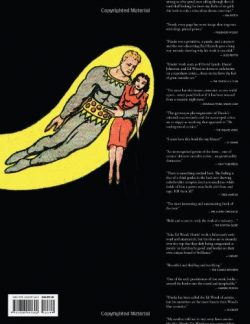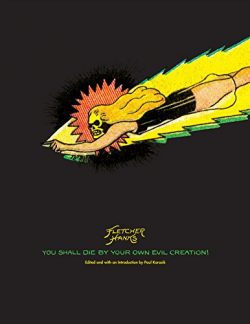

By Fletcher Hanks, edited by Paul Karasik (Fantagraphics Books)
ISBN: 978-1-606699-160-2 (TPB)
Although he was a pioneering auteur and prolific creator, the work of troubled artisan Fletcher Hanks (December 1st 1889 – January 22nd 1976) was all-but lost to posterity for decades following the Darwinian dawn of the American comic book. Happily, he was rediscovered relatively recently by comics’ intelligentsia in such magazines as Raw!
Hank’s unique visual style and frankly histrionic manner of storytelling resulted in only 51 complete stories created over less than three years (1939-1941) – but those were during the make-or-break, crucially formative times that would shape the industry for decades to come.
Like so many of his contemporaries, Hanks was an artist plagued by a dependence on alcohol and a tendency to violence. Surviving on odd jobs and as a mural painter, he abandoned his wife and four children in 1930 and disappeared until the incredible commercial drive to fill comic book pages saw him resurface in 1939 as part of the Jerry Iger/Will Eisner production “Shopâ€. Here he generated whole stories (script, art, lettering and probably even colour-guides) for some of the most successful publishers of the Golden Age. All were fast-paced, action-packed, relentless blood-&-thunder thrillers, underpinned by what might well be hallucinogenic delirium…
Hanks is now globally prominent in art circles and regarded as a key Outsider Artist – defined by critic Roger Cardinal as an English-language equivalent to the French movement Art Brut or Raw/Rough Art: works created outside the boundaries of official culture. Jean Dubuffet connected the phenomenon especially and specifically to the paintings and drawings of insane asylum inmates but Cardinal extended the definition to include Naïve art, some Primitivism and sustained bodies of work by creators working at all fringes of the mainstream.
In his woefully short career, the impact of those 51 stories were further reduced since he only worked in a few returning characters. This book follows on from and concludes the complete works compilation begun in editor Karasik’s I Shall Destroy all the Civilized Planets! (which I simply must track down and review too).
Presented in chronological order, this book contains seven Space Smith adventures – ‘Captured by Skomah!’ (Fantastic#1, December 1939), ‘The Martian Ogres!’ (Fantastic #2, January 1940), ‘The Leopard Women of Venus’ (#3, February), ‘The Thinker’ (#4, March), ‘The Hoppers’ (#5, April), ‘The Vacuumites’ (#6, May) and ‘Planet Bloodu’ (#8, July): a single tale of Tabu, Wizard of the Jungle from Jungle Comics #1 (‘The Slave Raiders’, January 1940) plus a batch of red-blooded lumberjack yarns starring Big Red McLane: ‘King of the North Woods’, ‘The Timber Thieves’, ‘The Lumber Hijackers’, ‘The Sinister Stranger’, ‘The Paper Racketeers’, ‘Sledge Sloan Gang’, ‘The Monk’s War Rockets’ and ‘Searching for Sally Breen’ from the monthly Fight  Comics (#1, January 1940, and #3 through 9).
The incomparable Stardust the Super-Wizard (whose slick, sleek costume surely influenced Britain’s Mick Anglo when he redesigned Captain Marvel into All-English Marvel Man in 1954!) is stirringly represented by ‘Rip the Blood’(Fantastic #2 January 1940), ‘The Mad Giant’ (#4), ‘The Emerald Men of Asperus’ (#8) ‘The Super Fiend’ (#10), ‘Kaos and the Vultures’ (#12), ‘The Sixth Columnists’ (#14) and ‘The World Invaders’ (Fantastic #15, February 1941).
No violent genre was beyond Hanks and prototype sword-wielding barbarian hero Tiger Hart rousingly romped through the jungles of Saturn in ‘The Dashing, Slashing Adventure of the Great Solinoor Diamond’ in Planet Comics #2 (February 1940).
From early 1940, Daring Mystery #4 and #5 supply ‘Mars Attacks’ and ‘Planet of Black-Light’, two exploits of brawny, clean-limbed Whirlwind Carter of the Interplanetary Secret Service, whilst Yank Wilson, Super Spy Q-4 performed much the same role for the contemporary USA in ‘The Saboteurs’ from Fantastic #6 (May 1940).
For me the biggest, most enjoyable revelation is the captivating batch of uncanny tales featuring the frankly indescribable Fantomah. The “Mystery Woman of the Jungle†– a blend of witch, goddess and reanimated corpse – used startling magic to monitor and defend the green places of the world against all manner of threats from poachers to mad scientists and aliens.
Her beguiling feats open with ‘The Elephants Graveyard’ (Jungle Comics #2, February 1940) and just get wilder and wilder, continuing with ‘The Super-Gorillas’ (#4), ‘Mundoor and the Giant Reptiles’ (#5), ‘Phantom of the Tree-Tops’(#6), ‘The Temple in the Mud Pit’ (#8), ‘The Scarlet Shadow’ (#11), ‘The New Blitzers’ (#12) and ‘The Tiger-Women of Wildmoon Mountain’ before ominously concluding with ‘The Revenge of Zomax’ from February 1941’s Jungle #14.
These stunningly surreal and forceful stories created under the pseudonyms Barclay Flagg, Hank Christy, Henry and Chris Fletcher, Charles Netcher, C.C. Starr and Carlson Merrick are a window into a different, bolder, proudly unconventional era and the troubled mind of a true creative force. Seen in conjunction with Karasik’s insightful introduction and the many early sketches and illustrations from before that too-brief foray into comics, these pages present an intimate glimpse of a fascinating man at a crossroads he was clearly able to shape but never grasp.
This is a magical book for both fans of classical comics and the cutting edge of modern art: and just in case you were wondering, the stories are weird but read wonderfully.
It Must Be Yours!!!
All stories are public domain but the specific restored images and design are © 2009 Fantagraphics Books.
